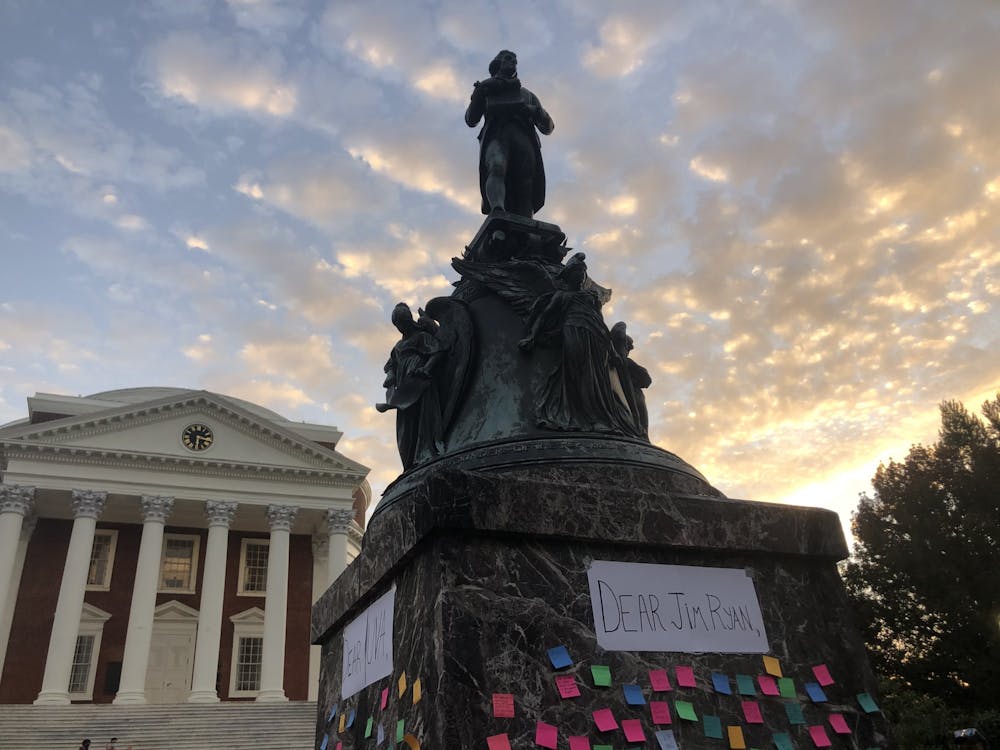Lea en español
On Friday, Oct. 23, approximately 100 students gathered in front of the Thomas Jefferson statue at the Rotunda in response to University President Jim Ryan’s statement that the University would not “walk away from Thomas Jefferson” under his leadership.
In an essay published Oct. 2, Ryan addressed calls to contextualize the Thomas Jefferson statue at the Rotunda and responded to the ongoing controversy surrounding signs on the Lawn.
“I do not believe the statue should be removed, nor would I ever approve such an effort,” Ryan wrote.
The Board of Visitors voted to recontextualize — either via a plaque or website — the Jefferson statue in a Sept. 11 meeting, among other changes to the University’s historic landscape, to acknowledge Jefferson’s ownership of enslaved people as well as the usage of enslaved labor to build the University.
Friday’s event in response to Ryan’s statement was engineered to facilitate community building and healing through speeches focused on mutual care, discussion groups and periods of reflection. One speaker said the mission of the gathering was to “reinvigorate and sharpen our vision for a better world because we believe firmly and boldly that another world was possible.”
The evening’s agenda included a series of student speakers, community-building discussion groups and a concluding exercise wherein students were invited to write responses to a series of prompts about Ryan’s statement.
Student organizers prepared a series of relationship-building discussion prompts as well as critical engagement questions to spark discussion among attendees. Physically distanced groups of three to five people formed and sat on the ground to share their perspectives on Ryan’s statement and feelings about how the University has handled the pandemic and the academic semester.
While the event was motivated by a rejection of Ryan’s statement about the University’s founder, the organizers sought to cultivate an environment that was forward-looking and uplifting.
Emphasis was placed on the need for community healing and mutual care. Speakers lamented the “mental, emotional and physical unwellness” of students and urged students to “find time for joy.”
“We all have a responsibility to … unlearn the whitewashed history of this university and this country, and to free every single person who is oppressed and perpetually subjugated to the toxic systems of white supremacy, neoliberalism and racial capitalism,” one speaker said.
Organizers of the event would like to remain anonymous in their comments in the interest of their safety and to spotlight the community healing instead of their individual selves.
The student organizer who contributed quotes for this article provided the following statement of anonymity — “I ask for anonymity primarily for my, and the other organizers’, safety. We’d like to keep our names — and pictures — out of the press in order to de-center ourselves, avoid retaliation and place greater emphasis on the event itself.”
Critical engagement questions prompted students to consider how the University’s history connects to present realities as well as to reflect on the University’s contemporary operations.
“When someone like President Ryan vows to uphold Thomas Jefferson's ideals, we all need to seriously interrogate what that means and how those values are in direct opposition to the very existence of Black and Indigenous peoples,” one organizer said.
When asked about what he thought of the struggle to reconsider the University’s founder, first-year College student Patrick Cloud, who attended the event, said that he felt that the University would never entirely abandon the legacy of Thomas Jefferson.
“We’ll remember him, but in context,” Cloud said.
The context in which to consider Thomas Jefferson’s legacy was the primary question up for debate at Friday’s event.
One speaker proposed that the University should reframe Mr. Jefferson’s University as Sally Hemings’ University. At a minimum, they said, the community should call attention to her history and the reality that at 16 years old, she was raped and impregnated by the 44-year-old Thomas Jefferson.
In an email to The Cavalier Daily, another organizer suggested “constructing spaces that are accessible, making tuition more affordable, providing hazard pay and a living way for all workers” and “recruiting and retaining more — tenured — faculty of color” as concrete ways to achieve progress. Taking down statues and removing the names of white supremacists from University buildings are also steps in the direction of progress, according to this student.
In a final exercise of reflection, students were invited to respond to prompts about the University by writing remarks on Post-it notes and plastering them on the base of the Thomas Jefferson statue. Prompts included “Dear Jim Ryan,” “Dear white supremacy,” “Dear U.Va.” and “Dear future and radical imagination.”
When asked what she hoped the event would accomplish, one student speaker said that she hopes “attendees were able to learn, connect and engage with their community in a meaningful, discursive way.”
The aforementioned organizer also emphasized that “the role of students is to struggle together in order to uproot the University from its origins. This means supporting, advocating and acting in solidarity with and in service of BIPOC, low-income and undocumented students.”
At the event’s closing, chants of “This is what democracy looks like” filled the air.







